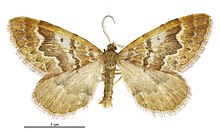| Asaphodes exoriens | |
|---|---|

| |
| Male | |
| Scientific classification | |
| Domain: | Eukaryota |
| Kingdom: | Animalia |
| Phylum: | Arthropoda |
| Class: | Insecta |
| Order: | Lepidoptera |
| Family: | Geometridae |
| Genus: | Asaphodes |
| Species: | A. exoriens |
| Binomial name | |
| Asaphodes exoriens (Prout, 1912) | |
| Synonyms | |
| |
Asaphodes exoriens is a species of moth in the family Geometridae. This species is endemic to New Zealand and has been found in Central Otago. This is an alpine species and frequents open grassy habitat. They can also be found in upland wetland habitat at altitudes between 800 and 1100 m. Adults are on the wing in March.
Taxonomy
This species was described by Louis Beethoven Prout in 1912 as Larentia exoriens using material collected by George Howes at Glenorchy in Otago in March. In 1917 Edward Meyrick placed this species in the genus Xanthorhoe. George Hudson discussed and illustrated this species under the name Xanthorhoe exoriens in his 1928 publication The Butterflies and Moths of New Zealand. In 1939 Louis Beethoven Prout placed this species in the genus Larentia. This placement was not accepted by New Zealand taxonomists. In 1971 John S. Dugdale assigned this species to the genus Asaphodes. In 1988 John S. Dugdale confirmed this placement. The male holotype specimen, collected at Glenorchy, is held at the Natural History Museum, London.
Description

Hudson described the species as follows:
The expansion of the wings is 1+1⁄8 inches. All the wings are ochreous, the forewings being strongly tinged with reddish on the costa and extreme base; the median band consists of four very irregular faint blackish lines, the second and third lines forming three distinct loops; there is a distinct blackish discal dot and the outer edge of the median band is very strongly waved, with distinct projections above and below the middle; the subterminal area is broad with one or two very faint cloudy marks; all the wings have a terminal series of minute brown marks, and all the cilia are plain ochreous without bars. The underside of the hind-wings is dull reddish-ochreous without bars. The underside of the hind-wings is dull reddish-ochreous without distinct markings.
Distribution
This species is endemic to New Zealand. It has only been found in Central Otago.
Biology and life cycle
A. exoriens is on the wing in March.
Habitat and host species
A. exoriens is an alpine species that frequents open grassy habitat. The adult moths are found in upland wetland habitat at altitudes of between 800-1100m.
References
- ^ "Asaphodes exoriens (Prout, 1912)". www.nzor.org.nz. Landcare Research New Zealand Ltd. Retrieved 21 August 2018.
- ^ Dugdale, J. S. (1988). "Lepidoptera - annotated catalogue, and keys to family-group taxa" (PDF). Fauna of New Zealand. 14: 173. Archived from the original (PDF) on 27 January 2019. Retrieved 21 August 2018.
- Prout, L. B. (1912). "Notes on the nomenclature of the New Zealand Geometridae, with descriptions of a new species". Transactions and Proceedings of the New Zealand Institute. 44: 52–54 – via Biodiversity Heritage Library.
- Edward Meyrick (December 1917). "Revision of New Zealand Notodontina". Transactions and Proceedings of the New Zealand Institute. 49: 248–273. ISSN 1176-6158. Wikidata Q110727829.
- ^ Hudson, G. V. (1928). The Butterflies and Moths of New Zealand. Wellington: Ferguson & Osborn Ltd. p. 121. OCLC 25449322.
- Prout, L. B. (1939). "Geometridae: Fauna Indo-Australica". The Macrolepidoptera of the World. 12: 264 – via Biodiversity Heritage Library.
- R. C. Craw (April 1987). "Revision of the genus Helastia sensu stricto with description of a new genus (Lepidoptera: Geometridae: Larentiinae)". New Zealand Journal of Zoology. 14 (2): 269–293. doi:10.1080/03014223.1987.10422997. ISSN 0301-4223. Wikidata Q54670161.
- Dugdale, J. S. (1971). "Entomology of the Aucklands and other islands south of New Zealand: Lepidoptera, excluding non-crambine Pyralidae". Pacific Insects Monograph. 27: 55–172.
- Gordon, Dennis P., ed. (2010). New Zealand inventory of biodiversity: Kingdom animalia: chaetognatha, ecdysozoa, ichnofossils. Vol. 2. p. 459. ISBN 978-1-877257-93-3. OCLC 973607714. OL 25288394M. Wikidata Q45922947.
- Dickinson, K. J. M.; Mark, A. F.; Barratt, B. I. P.; Patrick, B. H. (March 1998). "Rapid ecological survey, inventory and implementation: A case study from Waikaia Ecological Region, New Zealand". Journal of the Royal Society of New Zealand. 28 (1): 83–156. doi:10.1080/03014223.1998.9517556. ISSN 0303-6758.
- Patrick, Brian (2014). "Ecology and conservation of the rare moth Asaphodes frivola Meyrick" (PDF). Weta. 47: 17–38. Archived from the original (PDF) on 2016-01-27.
| Taxon identifiers | |
|---|---|
| Asaphodes exoriens | |
| Larentia exoriens | |